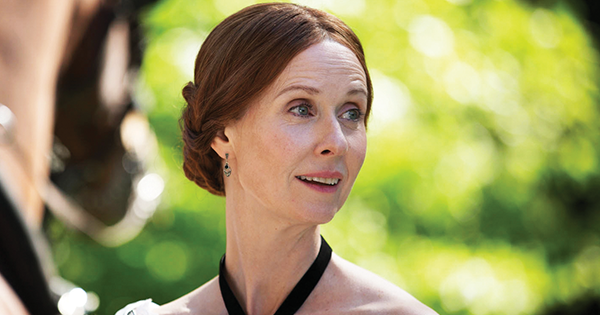
We open onto a black screen. We hear the clack of footsteps, almost like the very voice of doom. Suddenly the screen breaks into light, and we witness a panorama of 15 young women in lace collars, standing in three ragged rows, like some silent chorus. Only one of the women is really discernible. She’s in the second row—it’s young Emily Dickinson, played by Emma Bell with a ferocious, quiet dignity. The other girls are almost invisible in their plainness.
Someone is addressing this silent chorus in a slightly sinister voice. The camera twists about to reveal Mary Lyon (Sara Vertongen), headmistress of Mount Holyoke Female Seminary, the first women’s college in America—it’s 1848. Mary Lyon isn’t fooling around. She insists that the souls of these young women are at stake.
“Do you wish to come to God and be saved?” she asks.
The chorus remains silent. Miss Lyon treats the young women like a handful of dolls, shuffling them about in her own fashion. She orders those who consider themselves Christian and saved to step to the right, and those who still have some hope of being saved to move to the left. Only Emily remains, with the languid light of three windows behind her.
Mary Lyon in all her starkness is wearing a cap with white wings—wings are a motif throughout this film, as if eternity were flitting about somewhere in the background.
Miss Lyon interrogates Emily. “Are you in the Ark of Safety?”
“No,” Emily answers without the slightest hesitation. And Mary Lyon condemns her as a “No-Hoper.”
Thus we have the opening scene of A Quiet Passion, Terence Davies’s stubbornly original and defiantly old-fashioned film about Emily Dickinson. Shot with a marvelous dance of light and the high drama of two opposing forces that will never budge, the scene has a stark clarity that we seldom find in commercial cinema.
Davies was wise to begin here. The importance of Dickinson’s two semesters at Mount Holyoke has often been overlooked. It was her first and very last long departure from her father’s house in Amherst, except for two sojourns in Cambridge, when a renowned Boston ophthalmologist attended to her failing eyesight. Dickinson seldom wrote about her stay at the seminary, and it did not seem to provide her with any lasting attachments. Yet here, away from home, she might have discovered the Promethean power that poet Susan Howe describes in My Emily Dickinson (1985).
Davies uses a clever device—the daguerreotype—to have Emma Bell morph into Cynthia Nixon, who plays Dickinson as an adult. Nixon is not the mousy and tubercular young girl from the single iconic portrait we have of the poet, circa 1847. Nixon is tall and lithe, often ferocious and witty at the same time—much closer to a second daguerreotype, discovered by a New England collector and first published five years ago. Taken in 1859, it shows two women sitting side by side, one of them staring defiantly at the camera. The picture suggests a possible love affair between Dickinson and Kate Anthon, a classmate of Emily’s sister-in-law. In her letters, the poet calls this phantom lady “Condor Kate.” There’s no mention of Condor Kate in A Quiet Passion. And it’s a pity.
After a recent screening of the film at Manhattan’s Morgan Library, Davies was very firm about not wanting to deal with Dickinson’s possible “lesbianism.” He was much more concerned about the modulations of the poet’s nuclear family—mother, father, sister, and brother. And he gives us a wondrous portrait of these creatures. Keith Carradine is particularly striking as Dickinson’s rigid yet loving father, who can never really fathom the Prometheus in his own house. Joanna Bacon is also quite fine as the poet’s sickly mother, who sleepwalks through the film in a catatonic state. Davies’s crafting of the poet’s younger sister, Vinnie (Jennifer Ehle), as a lesser Prometheus with her own powerful wit, shadows Nixon’s own performance. Actually, Vinnie was “full of Wrath, and vicious as Saul,” as the poet writes in one of her letters. She also surrounded herself with a troupe of cats that Emily despised.
But the film still turns on Nixon’s performance. A glimpse of her bisexuality might have provided a key to her volcanic shifts of mood. Whether or not Kate Anthon is etched out of the second daguerreotype, the confident woman who smiles at us in her old-fashioned dress could have been Cynthia Nixon’s twin. To Davies’s credit, he pursued Nixon—and waited four years until she was ready to play the poet. We see in her partly ravaged face the ravages of creation. In her own hypnotic performance, she will become the Emily Dickinson we now remember.

